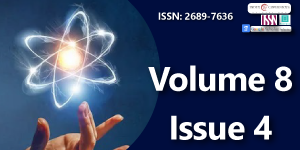Ether in Biquaternionic Presentatioin, Its Density and Properties
Main Article Content
Abstract
The biquaternionic model of the ether is presented as electro-gravimagnetic field, the state of which is described by the EGM strength biquaternion. Its complex scalar part determines the density of the ether, and the complex vector part characterizes the strength of the electric and gravimagnetic fields. The biquaternion gradient of the EGM strength biquaternion determines the biquaternion of EGM charge-current, which contains in the scalar part the electric charge and gravitational mass, and the vector part is formed by electric and gravimagnetic currents. This biquaternion wave equation (biwave Eq) is generalization of Maxwell equations.
The field’s analogue of the three Newton’s laws are presented in form of biwave equations. Representations of biquaternion of photons and elementary atoms are obtained as partial stationary solutions of biwave equations with a fixed oscillation frequency. The presence of a gravitational component of the EGM field of the photon is shown, which explains the light pressure
A field analogue of Newton's second law is presented as a biquaternion generalization of the Dirac system of equations. It describes the transformation of the EGM charge-current biquaternion under the influence of an external EGM field. It contains, in addition to all known physical forces, a number of new forces that are proposed for discussion and experimental verification. The biquaternion representation of Newton's third law of action and reaction in the scalar part is a well-known analogue of Bettie’s law on the power of forces acting on EGM charges and currents. Using the biquaternion model of the atom, a periodic system of atoms is constructed based on the structure of a simple musical scale.
Downloads
Article Details
Copyright (c) 2025 Alexeyeva LA.

This work is licensed under a Creative Commons Attribution 4.0 International License.
Alexeyeva LA. Newton’s laws for a biquaternionic model of electro-gravimagnetic fields, charges, currents, and their interactions. J Phys Math. 2009;1:Article ID S090604. Available from: https://doi.org/10.4303/jpm/S090604
Alexeyeva LA. Field analogues of Newton's laws for one model of the electro-gravimagnetic field. Hypercomplex Numbers Geom Phys. 2009;6(1):122-134.
Alexeyeva LA. Biquaternion differential algebra. Math J. 2010;10(4):5-13; 2011;11(1):33-41.
Alexeyeva LA. Biquaternions algebra and its applications by solving of some theoretical physics equations. Clifford Anal Clifford Algebras Appl. 2012;7(1):19-39. Available from: https://www.researchgate.net/publication/235358807_Biquaternions_algebra_and_its_applications_by_solving_of_sometheoretical_physics_equations
Alexeyeva LA. Transformation equation and its generalized solutions in differential algebra of biquaternions. Rep Natl Acad Sci RK. 2013;(4):12-19.
Alexeyeva LA. Differential algebra of biquaternions. Dirac equation and its generalized solutions. In: Progress in Analysis. Proc 8th Congr ISAAC, Moscow, 22-27 August 2013. 2013:153-161. Available from: https://www.scirp.org/reference/referencespapers?referenceid=1691176
Alexeyeva LA. Maxwell equations, their Hamiltonian and biquaternionic forms and properties of their solutions. Math J. 2016;(2):25-39.
Alexeyeva LA. Biquaternionic model of electro-gravimagnetic field, charges and currents. Law of inertia. J Mod Phys. 2016;7:435-444. Available from: http://dx.doi.org/10.4236/jmp.2016.75045
Alexeyeva LA. Biquaternionic form of laws of electro-gravimagnetic charges and currents interactions. J Mod Phys. 2016;7:1351-1358. Available from: http://dx.doi.org/10.4236/jmp.2016.711121
Alexeyeva LA. Periodic system of atoms as simple gamma in biquaternionic representation. In: Scientific Federation. II Int Conf Quantum Mech Nucl Eng. Paris, 23-24 September 2019;56. Available from: https://www.scirp.org/journal/paperinformation?paperid=86151
Alexeyeva LA. Biquaternionic model of electro-gravimagnetic fields interactions. In: Scientific Federation. Second Global Summit on Physics. Paris, 26-27 September 2019. p.19. Available from: https://www.opastpublishers.com/peer-review/biquaternionic-model-of-electrogravimagnetic-fields-and-interactions-786.html
Alexeyeva L. Periodic system of atoms in biquaternionic representation. J Mod Phys. 2018;9(8):1633-1644. Available from: https://doi.org/10.4236/jmp.2018.98102
Alexeyeva LA. Biquaternions of photons. Light. J Probl Evol Open Syst. 2020;22(1):75-82.
Alexeyeva LA. Ether and photons in biquaternionic presentation. Int J Appl Phys. 2020;7(1):1-7. Available from: https://doi.org/10.14445/23500301/IJAP-V7I1P114

